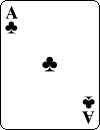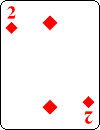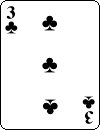
Mathematical Card Tricks
The concepts of permutations and invariants provide material for some excellent tricks. Bob Hummer, who was active in the 1940s and 50s, was one of the great earliest innovators in this field. According to Gordon Bean, ``He lived in Chicago and Baltimore, performed professionally, and marketed his original creations to other magicians.'' His spirit lives on in the prediction trick that follows. It has little to do with cards when all is said and done!



Effect: Any Ace, 2 and 3 are placed face up in a row on the table. Turn away, and invite the victim to mentally choose one of the cards, turn it over on the table, and then also turn over the other two cards, having first switched their positions. You collect the cards, cut the packet repeatedly, and place them face down in a row on the table again. The victim guesses which card they mentally choose, and turns that one over giving no hint as to whether they succeeded or not. You instantly either congratulate them, or express disappointment at their choice and turn over the correct card, saying ``I think you meant this one.'' The trick may be repeated, and some audiences get more intrigued with each performance!
Method: Pick up the cards so that from top to bottom you have the rightmost card, the middle card, and the leftmost card. Cut cards to the bottom, one or two at a time, over and over with no obvious pattern, while secretly keeping count. Stop once 10, or 13, or 16, have been moved. Deal out the top card to the middle, the second card to the right, and the third to the left, and adjust your mental image of these three positions to read 3, 2, 1 from left to right (a reversal of the earlier placements). Invite the victim to turn over whichever card they think was theirs, say it's in position i. If the card with value i is in this position, congratulate them for an inspired guess, otherwise a card with value j not equal to i is in position i, and you quickly turn over the card in the third position k not equal to i or j and correct their choice.



For instance, if they turn over the Ace in position 3 (the left), you turn over the middle card (position 2), and that is indeed the card they first selected.
Mathematics:
This trick is about permutations in the symmetric group on {1,2,3}, which we
take to represent the initial positions of the Ace, 2 and 3. The victim's
actions effect an unknown transposition ![]() . The manner in which you
pick up the three cards reverses their order, which is equivalent to the
permutation (1 3), another transposition. The cutting of s = 1 (mod 3) cards
to the bottom of the packet boils down to the 3-cycle (1 3 2), and the final
placement of the cards on the table (disregarding the left-right switch for now)
is the same as the transposition (1 2). Since (1 2)(1 3 2)(1 3)
. The manner in which you
pick up the three cards reverses their order, which is equivalent to the
permutation (1 3), another transposition. The cutting of s = 1 (mod 3) cards
to the bottom of the packet boils down to the 3-cycle (1 3 2), and the final
placement of the cards on the table (disregarding the left-right switch for now)
is the same as the transposition (1 2). Since (1 2)(1 3 2)(1 3)
![]() =
= ![]() ,
using the convention that permutations are multiplied from right to left, we
see that knowing the identify of just one of the cards reveals what
,
using the convention that permutations are multiplied from right to left, we
see that knowing the identify of just one of the cards reveals what
![]() is:
the left-right switch is just to make it less obvious.
is:
the left-right switch is just to make it less obvious.
Bonus points: Different pick-up and dealing orders (and even numbers of cut cards) may be used to the same effect, provided that the algebra works out as above. If you can compute the permutation products on the fly, you can let the victim determine the pick-up order and number of cards cut, because an appropriate dealing order will ensure that the trick still works.
Source: This invention of Bob Hummer's, as adapted by Max Abrams, appears in Bob Longe's Easy Magic Tricks (Sterling, 1994), where Martin Gardner is also credited!
Revised 10/26/00
4. It's as easy as one, two, three